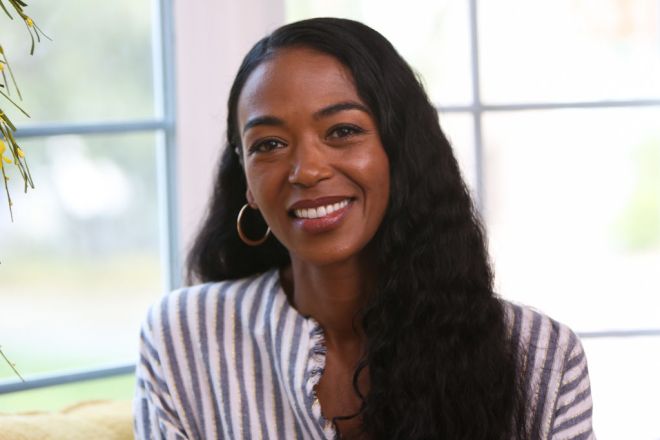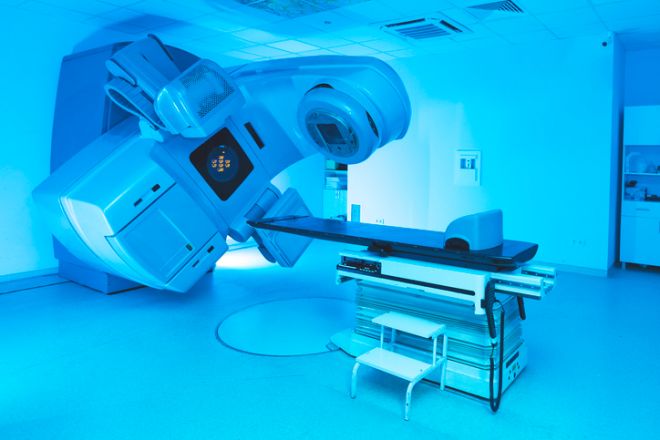After Ananda Lewis’ Death: A Look At Alternative Cancer Treatment
After Ananda Lewis’ Death: What Black Women Need To Know About Alternative Breast Cancer Treatments - Page 2
Share the post
Share this link via
Or copy link

Beloved MTV VJ and television host Ananda Lewis passed away June 11 at the age of 52 after a battle with breast cancer, leaving fans across the country in shock and mourning. Her passing has sparked discussion about treatment choices and the role of alternative medicine in cancer care, with many wondering if she would still be here had she taken a conventional route to treatment.
Lewis first discovered a lump in her right breast during a self-exam in 2018. A year later, she was officially diagnosed with HER2-negative Stage 3 breast cancer, as she revealed in a January interview with Essence. Rather than undergo a double mastectomy—like doctors recommended—or pursue conventional cancer treatments like chemotherapy or radiation, Lewis chose an alternative healing path, a decision influenced in part by her mother’s difficult experience with traditional cancer care.
“It’s not that I don’t trust the medical community. I do, with certain things, but I see a flaw in how they think about treating cancer,” she explained. “So I knew that I would address it in a different way. I wanted to start by figuring out why my body was creating cancer and how to change the terrain.”
Love MadameNoire? Get more! Join the MadameNoire Newsletter
We care about your data. See our privacy policy.
While doctors have consistently cautioned against relying exclusively on alternative healing methods, questions remain about their safety—particularly for Black women. Early detection is critical, as Black women face a 40% higher breast cancer mortality rate than their white counterparts.
RELATED CONTENT: Double Mastectomy Treatment May Not Increase Cancer Survival Rate, New Study Reveals
What kind of alternative cancer treatment did Ananda Lewis receive?
In her interview, Lewis described the comprehensive alternative regimen she followed: monthly ultrasounds conducted by her breast surgeon to monitor tumor growth, high-dose vitamin C infusions, hyperbaric oxygen therapy, qigong—an ancient Chinese practice that combines physical postures and breathing techniques—along with energy healing practices, prayer, fasting, and dietary changes. She managed all of this while navigating the emotional strain of ending a decade-long relationship with her son’s father. By early 2020, her scans showed the tumor was still growing, but at a slow pace.
Notably, Lewis is not alone in turning to alternative medicine as part of her cancer treatment. A growing number of cancer patients are incorporating complementary or alternative therapies into their care. In fact, a 2023 study published in JCO Oncology Practice found that 70.2% of surveyed patients reported using some form of complementary or alternative medicine (CAM), excluding mind-body practices.
The study, conducted at two cancer centers in the same city between 2020 and 2021, surveyed 749 patients. Among them, 42.2% said they used CAM to manage symptoms, 30.4% to treat the cancer itself, and 15.5% to support their mental health. Others cited general wellness or personal reasons (11.8%). Vitamin D supplements were the most commonly used therapy (32.1%), followed by fish oil (11.6%) and a vegetarian diet (6.1%).
Why do women opt for alternative cancer care?
Choosing between traditional and alternative medicine after a cancer diagnosis is a deeply personal and often difficult decision. While medical data can provide guidance, ultimately, the path each person takes depends on their values, experiences, and beliefs. According to The American Cancer Society, the five-year relative survival rate for breast cancer detected at its earliest stage is an encouraging 99%. Still, many patients hesitate to begin traditional treatments right away due to concerns about the intense and sometimes harmful side effects.
Chemotherapy, for example, is a widely used cancer treatment that works by killing or slowing the growth of cancer cells—but it can also have a significant impact on quality of life, Web MD notes. Common side effects include extreme fatigue, nausea, vomiting, hair loss, changes in appetite, mouth sores, diarrhea or constipation, and peripheral neuropathy, a form of nerve damage that can cause pain, tingling, or weakness, especially in the hands and feet.
Radiation therapy, another standard treatment, uses high-energy rays to destroy cancer cells but can also harm nearby healthy tissue, leading to skin issues, fatigue, and other complications.
For Lewis, fear of traditional treatments was a major factor in her decision. She had long been wary of mammograms and was particularly concerned about radiation exposure, according to a report by ABC News.
“For a really long time, I have refused mammograms, and that was a mistake,” Lewis shared on Instagram when she went public with her diagnosis in October 2020. “If I had done the mammograms from the time they were recommended when I turned 40, they would have caught the tumor in my breast years before I caught it through my own self-exam.”
Expensive costs for traditional and alternative cancer treatment can be a barrier.

Dr. Cary Gross, founder and director of Yale School of Medicine’s Cancer Outcomes, Public Policy, and Effectiveness Research Center, says it’s no surprise that many patients hesitate to pursue chemotherapy. Beyond the fear of difficult side effects, the cost alone can be a major deterrent. Some procedures are “ridiculously expensive,” Gross told HuffPost on June 12, noting that many people with cancer also struggle with mistrust—both in the medical system and the motivations behind certain treatment recommendations.
For those with health insurance, out-of-pocket costs for chemotherapy typically range from 10% to 15% of the total bill, according to CostHelper.com. But for uninsured patients, treatment can cost anywhere from $10,000 to over $200,000, depending on the type of cancer, the stage of disease, and the medications involved.
Alternative medicine isn’t necessarily a cheaper route either. According to the National Institutes of Health, Americans spend an estimated $30.2 billion each year out-of-pocket—without insurance coverage—on alternative health approaches, including visits to chiropractors or massage therapists, as well as vitamins and dietary supplements.
While some insurance companies may cover select alternative treatments like homeopathy or naturopathy, coverage is generally limited. The American Cancer Society notes that insurers typically only reimburse for treatments that are proven to be safe, effective, and medically necessary for a specific condition. If an alternative therapy lacks strong evidence of benefit, it’s unlikely to be covered.
“I’ve seen patients mortgage their home, drain their entire finances for presumably magic bullets that they’ve seen online,” Dr. Elizabeth Comen, a breast oncologist at NYU Langone Hospital, revealed to ABC News during an interview published June 14.
Lewis experienced the financial roadblocks that come with cancer treatment firsthand.

“I felt I was doing well, and my doctors agreed,” she recalled to Essence. But then the COVID-19 pandemic changed everything. With limited options available in California due to lockdowns and overwhelmed healthcare systems, she traveled to Arizona, where clinics remained open.
There, she underwent 16 weeks of integrative cancer therapy that included acupuncture, genetically targeted low-dose chemotherapy, and cryoablation—an FDA-approved procedure that kills cancer cells by freezing them with injected gas.
The results were encouraging: Lewis’ cancer regressed from Stage 3 to Stage 2, her lymph nodes cleared, and her tumor shrank significantly. But the treatments came at a steep price. Without insurance coverage for much of the care, she was forced to pause her therapies for more than two years to focus on supporting herself and her son.
“I struggled to pay for the ongoing treatments that would have kept things at bay, and then I lost my insurance. It was two and a half years before I could really do any more effective treatment. I needed to find work. I stopped focusing on the cancer because there were more pressing concerns, even though that sounds crazy to say,” she explained.
By 2023, her cancer progressed to Stage 4.
Alternative medicine should be done in conjunction with traditional medicine, doctors say.

Dr. Comen explained that complementary therapies can be beneficial—but only when used alongside standard, evidence-based cancer treatments. According to Yale Medicine, an estimated 48% to 88% of cancer patients incorporate some form of alternative care—ranging from vitamins and supplements to meditation, tai chi, yoga, bee venom, or restrictive diets—into their overall treatment plans. However, the effectiveness of this strategy varies greatly depending on the type of cancer and if the patient is willing to undergo traditional treatment in tandem.
In a 2019 study, Yale researchers analyzed data from 1,290 patients with breast, prostate, lung, or colorectal cancer in the National Cancer Database. They compared outcomes between 258 patients who used alternative medicine and 1,032 who did not. The study found that those using alternative therapies were significantly more likely to refuse one or more components of conventional cancer treatment recommended by their doctors, such as chemotherapy, radiation, or surgery. This refusal was linked to an increased risk of death compared to patients who followed standard treatment protocols without adding alternative therapies.
Research shows that patients who rely solely on alternative medicine and reject conventional treatment face a two to four times higher risk of death. A 2018 study from Yale further revealed that breast and colorectal cancer patients who chose alternative therapies were nearly five times more likely to die, and patients with non-metastatic lung cancer faced more than double the risk compared to those who underwent standard treatment.
Ultimately, early detection remains the most powerful tool in the fight against cancer. Doctors say that it is imperative to stop cancer in its tracks as it will prevent the disease from spreading around the body causing the need for more intense treatment down the line.
RELATED CONTENT: New Study Finds Breast Cancer On The Rise — More Women Under 50 Are Being Diagnosed








